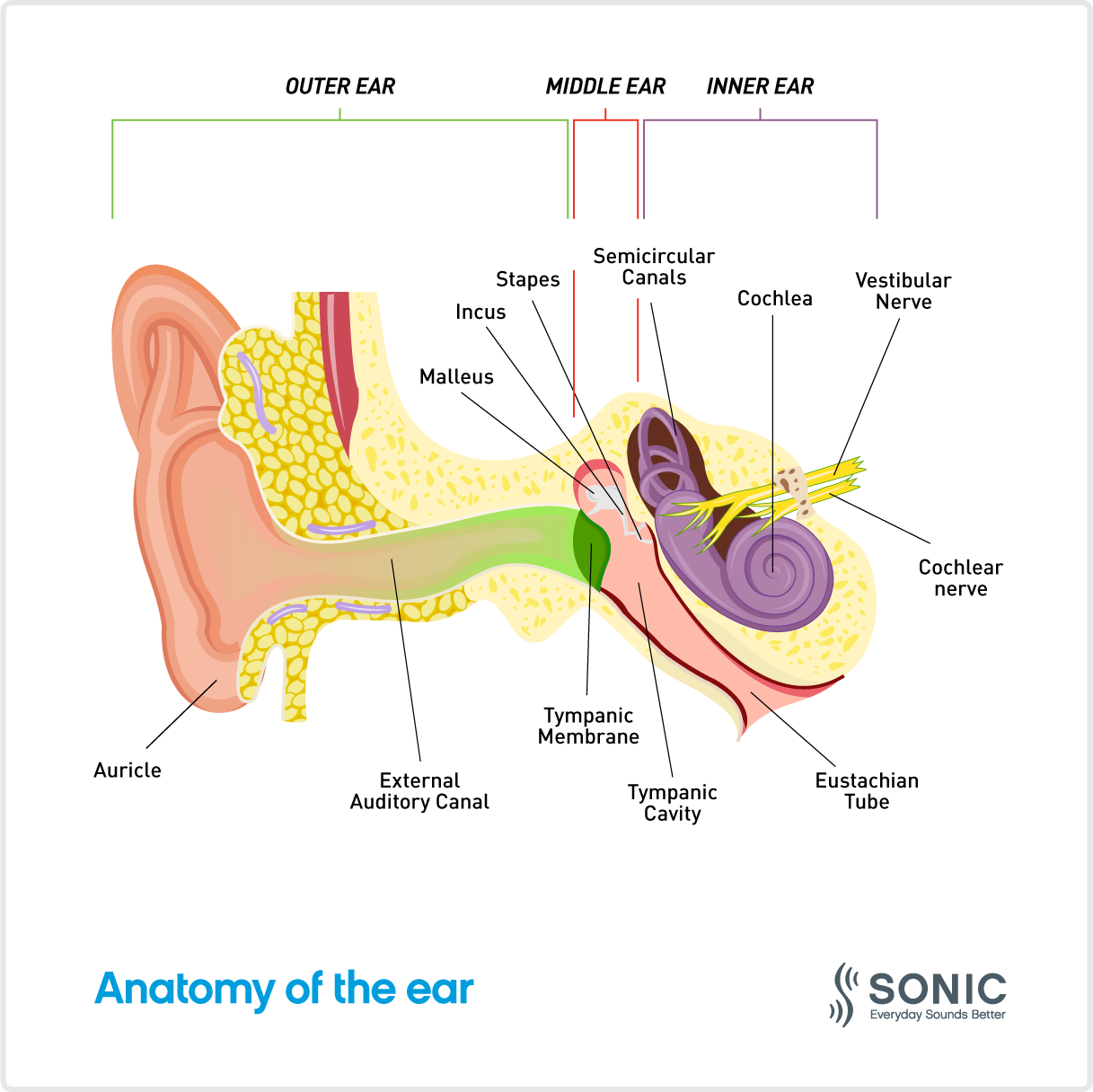Did you know that hearing loss can manifest in three general locations within your ear? If you suspect you may have hearing loss, you may want to learn the basic anatomy of the ear to give you a better understanding of where the loss may be coming from before you seek help from a hearing care professional. With this knowledge, you’ll be better prepared when learning the results of your examination.
The diagram below shows the three main parts of the ear: outer, middle, and inner. Each part plays a critical role in helping you hear.

Outer ear (green shading):
The outer ear includes the auricle, external ear canal, and tympanic membrane, better known as the ear drum. The outermost cartilaginous structures collect sound waves from the listening environment and funnel the acoustic vibrations to the more interior parts of the ear. Interestingly, the long, narrow shape of the ear canal provides a boost for high-frequency sounds. This natural amplification gives you a slight advantage when listening to conversational speech, which is composed of high-frequency sounds. As you may expect, if sound is partially or completely blocked in the outer ear area before it reaches the inner ear (for example, with wax buildup), a hearing loss may occur. The good news is that this type of conductive hearing loss is often temporary once diagnosed and treated by a medical professional.
Middle ear (red shading)
The middle ear starts at the tympanic membrane. The three smallest bones of the body—the malleus, incus, and stapes, known collectively as ossicles—are connected to the eardrum and transmit sound vibrations from the outer ear through the hollow middle ear cavity. The Eustachian tube joins the middle ear cavity with the nasal cavity and allows pressure to equalize between the middle ear and the throat. Conductive hearing loss in the middle ear is very common. For example, an ear infection can cause temporary hearing loss. Once the infection is medically treated with antibiotics or pressure equalization tubes, baseline hearing returns. Another middle ear condition is otosclerosis, in which one of the three bones behind the eardrum can’t transmit sound properly to the inner ear. In many cases, surgery is recommended. If you suspect a middle ear problem is causing your hearing loss, it is important to be evaluated by an ear, nose, and throat (ENT) doctor because the loss can often be treated successfully with medicine or surgery.
Inner ear (purple shading):
Finally, the inner ear is located behind the middle ear space. It contains the snail-shaped sensory organ known as the cochlea, as well as the cochlear nerve. The cochlea and cochlear nerve work together to convert sound received from the outer and middle ear into electrical signals that are sent to the brain, where hearing ultimately takes place. A sensorineural hearing loss occurs in the inner ear when factors such as increasing age, noise exposure, or genetics damage the delicate outer and/or inner hair cell receptors within the cochlea. A hearing test from a qualified hearing care professional can reveal your sensitivity to sounds across frequencies, from low to high. If a loss of hearing sensitivity that impacts communication is identified, the best treatment option to improve your hearing may be hearing aids. It is important to understand that even when speech is amplified loud enough to be heard, it may still sound unclear because this type of impairment causes distortion to the nerve, which cannot be restored by amplification.
Additional considerations:
A hearing loss from the inner ear can also overlap with a loss from the outer or middle ear. This condition is called a mixed hearing loss, and it occurs when sound is unable to be transmitted from the outer or middle ear to the inner ear properly and there is damage to the inner ear or nerve as well.
The bottom line:
If you suspect a hearing problem, the best course of action is to make an appointment with a hearing health care provider as soon as possible. Knowing the parts of the ear will help you better understand the type of hearing loss and where it’s coming from—and why certain treatment options may or may not be recommended. Find a hearing care professional to obtain a baseline hearing test and be sure to get retested periodically to monitor for changes over time. For additional online resources on hearing health, visit the Hearing Loss Association of America. And if you’re ready to start your journey to better hearing visit www.sonici.com.
When communication is clear and natural, you can focus on the moments that matter most. That’s how Sonic makes Everyday Sounds Better
.